TM
DLP Projector
MODEL
XD550U/XD560U/WD570U/XD360U-EST/WD380U-EST
Controlling the projector using a personal computer
This projector can be controlled by connecting a personal computer with RS-232C terminal.
PC-controllable functions:
• Turning the power ON or OFF
• Changing input signals
•
• Menu setting
Inputting commands by pressing the buttons on the control panel and remote control
Connection
RS-232C
terminal
RS-232C cable
SERIAL
D-SUB 9-pin
D-SUB 9-pin
Important:
• Connect the computer with the projector on a one-to-one basis.
• Make sure that your computer and projector are turned off before connection.
• Boot up the computer first, and then plug the power cord of the projector.
(If you do not follow this instruction, the Com port may not function.)
AUDIO
IN-1
AUDIO IN-3L
S-VIDEO
SERIAL
COMPUTER / COMPONENT VIDEO
USB-B
USB-A
AUDIO OUT
AUDIO
IN-2
AUDIO IN-3R
VIDEO
MONITOR OUT
IN-1
IN-2
(This illustration is XD550U/XD560U/WD570U.)
• Adapters may be necessary depending on the PC connected to this projector. Contact your dealer for details.
1. Interface
1.1 Pin assignment of SERIAL terminal (D-SUB 9-pin)
Pin
1
3
5
7
9
Description
NC
TXD
GND
RTS
NC
Pin
2
4
6
8
Description
RXD
NC
NC
CTS
1
2
3
4
5
6
7
8
9
1.2 Communications format
PROTOCOL
BAUD RATE
DATA LENGTH
PARITY BIT
STOP BIT
FLOW CONTROL
RS-232C
9600 [bps]
8 [bits]
NONE
1 [bit]
NONE
This projector uses RXD, TXD and GND lines for RS-232C control.
1
�
2. Control command configuration
The command consists of the address code, function code, data code, ACK/NAK, and end code. The length of the com-
mand varies among the functions.
Address code
Function code
Data code
ASCII
Character
‘30h’ ‘30h’
00
Function
Function
Data
Data
ACK/NAK
‘3Ah’ ‘4Eh’
:N
End code
‘0Dh’
[Address code]
[Function code]
[Data code]
[ACK/NAK]
[End code]
Fixed to 00. (‘30h’ ‘30h’ in the ASCII code)
Code unique to each control operation.
Data (value) unique to each control operation (Not always indicated.)
Code indicating the NAK return as described below
Fixed to :N (‘3Ah’ ‘3Eh’ in the ASCII code. Not added to ACK.)
Fixed to
.(‘0Dh’ in the ASCII code)
3. Control sequence
Computer
Projector
Sequence
Note
1
2
3
4
1 Send the command from the personal computer
to the projector.
The projector will send a return command after it
receives an end code.
2
3
4
The personal computer checks the command
and confirms if the sent command has been
received or not.
Use the check command to see if the projector
has executed the command.
If the projector does not receive commands
normally, that is, if the projector is not connected
physically or unable to receive commands, it
does not send out a return command.
The projector sends out a return command within
one second at the latest.
When the received command cannot be
executed, NAK is returned (as described below).
This projector sends various codes other than
the return code. When having a control
sequence by RS-232C, reject other codes from
the personal computer.
NAK return
In the following cases, the projector returns the command with “:N” added.
(1) Though the command sent from the computer is received by the projector successfully, it cannot be executed
because the projector is in the operation prohibition state.
(2) The data length of the sent command is incorrect or the command is invalid.
When a command is sent out during the following operations, it may not be executed.
(1) During signal switching
(2) In the process of the auto position
(3) After the power is turned on.
The projector receives no commands for about 20 seconds (or for 2 minutes at the longest if the lamp does not
light up promptly as the life is expiring). In this case, the projector returns the received command with NAK
added.
The return command is sent out within 1 second at the latest.
When sending commands successively, wait to receive the return command of the current command before sending
a next command.
The projector may not receive a command when the splash screen is being displayed immediately after turning on
the power. Use command “00r10” to cancel the splash screen.
While using the LAN terminals, the LAN functions take precedence.
For the LAN terminals, the same commands as those for connecting with the TCP/IP (port number 63007) are avail-
able. Note, however, that the response becomes slightly slower than when using the RS-232C terminals. For the use
of LAN terminals, see page 11.
2
�
[Example 1] Turning ON the power. (Values enclosed in quotation marks are ASCII codes.):
Command sent from the PC
Status code returned
from the projector
‘30’ ‘30’ ‘21’ ‘0D’
00!
Description
Command for POWER ON
[Example 2] Selecting VIDEO as the input signal during auto positioning (Values enclosed in quotation marks are
‘30’ ‘30’ ‘21’ ‘0D’
00!
Command receipt confirmation (Command
echo back)
ASCII codes.):
Command sent from the PC
‘30’ ‘30’ ‘5F’ ‘76’ ‘31’
00_V1
Status code returned
from the projector
Description
‘30’ ‘30’ ‘5F’ ‘76’ ‘31’ ‘3A’ ‘4E’
00_v1:N
(During auto positioning)
Command for selecting VIDEO as the
input signal is sent out.
The command is received by the projector
but cannot be executed. (NAK return)
The flowchart on the next page shows the recommended operating sequence for your reference to create a pro-
gram.
3
�
[RS-232C control flowchart]
START
Sending out command
No NAK returned
Awaiting response
from projector
No response for
1 second or longer
NAK returned
Command is sent successfully.
Command is executed successfully.
Command is sent successfully.
Command execution fails.
Command sending fails.
Checking execution of
command (sending out
check command)
NG
OK
END
Check the following.
• Check that the function code is correct.
• Check that the data code is correct.
• Check that the projector is able to issue
the return command.
Check the projector’s operation using
the 00vST command.
Note: In the following cases, NAK is
returned even when the projector is
in normal condition.
• Immediately after the power is
turned on (about 20 seconds to 2
minutes)
• During input switching
• During auto positioning
• During password lock
Check the following.
• Check that the command begins with
• The projector is not supplied with AC
“00”.
power.
Check that AC power cord is
connected.
Turn on the power. (Turn on the circuit
breaker or main switch.)
• Not connected with the projector.
Check that the RS-232C cable is
connected.
Check the RS-232C cable for electrical
discontinuity.
[Method of checking state of projector]
Sending “ 00vST”
To normal operation
0-3
Checking response to “ 00vST”
4
6
5
Projector error
Send out “00vER” to check error details.
Recover from error state.
Enter password.
Send out “00PSLOK****”.
Projector is functioning.
[Compatibility with the former models]
To use the RS-232C commands designed for the former models of Mitsubishi projector, by inputting “00COMMAND0”,
the projector responds in the same way as the former models. (No NAK is returned.)
(For the recommended procedure to use the former command systems, see “Controlling the projector using a personal
computer” for FL7000U.)
ITEM
Changing the RS-232C command system
Function
Character
COMMAND 43h 4Fh 4Dh 4Dh 41h 4Eh 44h 0 (Former command system),
ASCII
1 (New command system)
Data
4
�
4. Command list
4.1 Operation commands
The operation commands are used for the basic operation setting of this projector. They may not be executed
while the signals are changed. The operation commands have no data codes. (When the commands for input
select are sent while the splash screen is being displayed,the splash screen is only canceled.)
Function
ASCII
Character
!
"
ITEM
POWER ON
POWER OFF
INPUT COMPUTER 1 _r1
INPUT COMPUTER 2 _r2
INPUT VIDEO
_v1
_v2
INPUT S-VIDEO
INPUT HDMI
_d1
_s1
INPUT PC Less Presentation
INPUT USB DISPLAY _s2
INPUT LAN DISPLAY _n1
Note
This command is invalid for 1 minute after the power is turned off.
This command is invalid for 1 minute after the power is turned on.
21h
22h
5Fh 72h 31h This command will not be executed in Stand-by mode or when the MUTE is executed.
5Fh 72h 32h This command will not be executed in Stand-by mode or when the MUTE is executed.
5Fh 76h 31h This command will not be executed in Stand-by mode or when the MUTE is executed.
5Fh 76h 32h This command will not be executed in Stand-by mode or when the MUTE is executed.
5Fh 64h 31h This command will not be executed in Stand-by mode or when the MUTE is executed.
5Fh 73h 31h This command will not be executed in Stand-by mode or when the MUTE is executed.
5Fh 73h 32h This command will not be executed in Stand-by mode or when the MUTE is executed.
5Fh 6eh 31h This command will not be executed in Stand-by mode or when the MUTE is executed.
[Example] When setting the input signal to COMPUTER 1. (Values enclosed in quotation marks are ASCII
codes.):
Command sent from the PC, etc.
‘30’‘30’‘5F’‘72’‘31’‘0D’
00_r1
Status code returned
from the projector
‘30’‘30’‘5F’‘72’‘31’‘0D’
00_r1
Description
Command for setting the input signal to
COMPUTER 1
Command receipt confirmation
(Command echo back)
4.2 Reading command diagram
The projectors operating status, such as POWER-ON/OFF a nd the currently selected input terminal, etc. can be
monitored.
ITEM
Character
IICSA
Function
Data (Receive)
Function
Data (Receive)
POWER ON
POWER OFF
INPUT COMPUTER 1
INPUT COMPUTER 2
INPUT VIDEO
INPUT S-VIDEO
INPUT HDMI
INPUT PC LESS PRESENTATION
INPUT USB DISPLAY
INPUT LAN DISPLAY
POWER ON/OFF IMPOSSIBLE
POWER ON/OFF POSSIBLE
NO SIGNAL SUPPLIED
SIGNAL SUPPLIED
vP
vP
vl
vl
vl
vl
vl
vl
vl
vl
vPK
vPK
vSM
vSM
1
0
r1
r2
v1
v2
d1
s1
s2
n1
0
1
0
1
76h 50h
76h 50h
76h 49h
76h 49h
76h 49h
76h 49h
76h 49h
76h 49h
76h 49h
76h 49h
76h 50h 4Bh
76h 50h 4Bh
76h 53h 4Dh
76h 53h 4Dh
31h
30h
72h 31h
72h 32h
76h 31h
76h 32h
64h 31h
73h 31h
73h 32h
6eh 31h
30h
31h
30h
31h
Use the following commands to obtain the values of the items in the INFORMATION menu.
ITEM
LAMP TIME (LOW)
RESOLUTION
Character
vLE
vRESO
Function
ASCII
Data (Receive)
76h 4Ch 45h
76h 52h 45h 53h 4F HHHHxVVVV
hhhhmm
“hhhh” and “mm” represent hours and minutes respectively.
“HHHH” and “VVVV” represent the horizontal and vertical resolutions respectively.
5
�
Use the following commands to obtain other information.
ITEM
Function
Character
ASCII
Data (Receive)
Model name vMDL 76h 4Dh 44h 4Ch ****************(within 16 characters)
Projector status
76h 53h 54h
vST
Error status
vER
76h 45h 52h
0 (Stand-by mode),
1 (Within 1 minute after POWER-ON (warm-up mode)),
2 (POWER-ON mode (including state of warning)),
3 (Cooling mode),
4 (Abnormal state (including shutdown due to an error)),
5 (State of functioning (menu display, dialog display, AV
MUTE, MAGNIFY, FREEZE, etc.)),
6 (Awaiting password entry)
Reading out error data (3 digits, hexadecimal numbers,
total 9 bits)
(MSB) xb1, xb2... xb8, xb9, 0, 0, 0 (LSB)
xb1: Fan error
xb2: Lamp error (The lamp goes out or does not light.)
xb3: Lamp warning 1 (The lamp life has expired.)
xb4: Lamp warning 2 (The lamp life is expiring.)
xb5: Temperature error
xb6: The temperature warning is being indicated.
xb7: Lamp cover open error
xb8: Fixed to 0.
xb9: States of other component abnormality
The PC sends the command without attaching the data code to it. On the other hand, the projector attaches to
the received command its current operating status as the data code and send it back to the PC.
[Example]When checking the currently selected input terminal (when the INPUT VIDEO is being selected).
(Values enclosed in quotation marks are ASCII codes.):
Command sent from the PC, etc.
Status code returned
from the projector
‘30’ ‘30’ ‘76’ ‘49’ ‘0D’
00vl
‘30’ ‘30’ ‘76’ ‘49’ ‘76’ ‘31’ ‘0D’
00vlv1
Description
Command for checking the input
terminal
Check result (VIDEO)
4.3 Remote commands (Not executable in stand-by mode. When the remote commands are sent while the splash
screen is being displayed, the sp lash screen is only canceled.)
The remote commands allow the computer to control the projector in the same way as by the remote control.
(Some operations cannot be controlled.) The remote commands have no data codes.
Button’s name on remote
Function
Character
ASCII
+/VOLUME
-/VOLUME
KEYSTONE
MAGNIFY
AV MUTE
UNEM
RETNE
AUTO POSITION
EZEERF
TCEPSA
USB DEVICE UNPLUG
3D
r06
72h 30h 36h
r07
72h 30h 37h
r43
72h 34h 33h
r02
72h 30h 32h
ra6
72h 61h 36h
r53
72h 35h 33h
r2b
72h 32h 62h
r4f
72h 34h 66h
r59
72h 35h 39h
45r
h43 h53 h27
01r
h03 h13 h27
r09
72h 30h 39h
4ar
h43 h16 h27
2er
h23 h56 h27
rb5 72h 62h 35h
r57 72h 35h 37h
6
�
[Example] When displaying the MENU selection bar. (Values enclosed in quotation marks are ASCII codes.):
Command sent from the PC, etc.
‘30’ ‘30’ ‘72’ ‘35’ ‘34’ ‘0D’
00r54
Status code returned
from the projector
‘30’ ‘30’ ‘72’ ‘35’ ‘34’ ‘0D’
00r54
Description
Command operating the same as the
MENU button
Command receipt confirmation
(Command echo back)
4.4 Direct commands (Not executable in stand-by mode. Possible only to read during muting.)
The direct commands are used to numerically adjust the volume and keystone.
When the computer sends the command without adding the setting value, the projector returns the received com-
mand with the current setting value added as a data code.
ITEM
Function
Character
ASCII
Data
VOLUME
KEYSTONE (vertical)
VL
KS
56h 4Ch
4Bh 53h ±20
00-21
How to set the value
Use the character or ASCII code as shown below to set the value.
Character
ASCII ‘2Bh’ ‘2Dh’ ‘30h’ ‘31h’ ‘32h’ ‘33h’ ‘34h’ ‘35h’ ‘36h’ ‘37h’ ‘38h’ ‘39h’
89
+
3
4
6
7
5
-
0
1
2
[Example] When setting the volume to 15. (Values enclosed in quotation marks are ASCII codes.):
Command sent from the PC, etc.
‘30’ ‘30’ ‘56’ ‘4C’ ‘31’ ‘35’ ‘0D’
00VL15
Status code returned
from the projector
Description
Command for setting the volume
‘30’ ‘30’ ‘56’ ‘4C’ ‘31’ ‘35’ ‘0D’
00VL15
Command receipt confirmation
(Command echo back)
4.5 Function commands (Not executable in stand-by mode. When the mute commands are sent while the splash
screen is being displayed, the splash screen is only canceled.)
The mute commands are used for the mute setting of this projector with the 0 (HEX: 30h) and 1 (HEX: 31h).
ITEM
AV MUTE
EZEERF
MAGNIFY
Function
Character
MUTE
ZRF
ASCII
4Dh 55h 54h 45h
hA5h25h64
MAGNIFY
4dh 47h 4eh 46h 59h
Data
0 (OFF), 1 (ON)
0 (OFF), 1 (ON)
0 (OFF), 1 (ON)
4.6 Menu setting commands (Not executable in stand-by mode. Possible only to read during muting.)
The menu setting commands are used for the menu setting of this projector. If the personal computer sends the
command without attaching the data code, the projector attaches to the received command its current setting
value as the data code and send it back to the PC.
ITEM
IMAGE
CONTRAST
BRIGHTNESS
COLOR TEMP.
3D
COLOR
TINT
SHARPNESS
CLOSED CAPTION
Character
IMG
Function
ASCII
49h 4dh 47h
PP
QQ
A
TDE
T
S
R
CC
50h 50h
51h 51h
41h
54h 44h 45h
54h
53h
52h
43h 43h
Data
0(AUTO), 1(Theater), 2(Presentation), 3(Standard),
4(Black Board), 5(White Board), 6(User)
±30
±30
1 (Mid), 2 (HIGH), 3 (LOW), 4 (USER)
0 (OFF),1 (ON)
±10
±10
±05
0 (OFF), 1 (CC1), 2 (CC2), 3 (CC3)
4 (CC4), 5 (T1), 6 (T2)
7
�
ITEM
LAMP MODE
STANDBY MODE
Character
LM
STBY
Function
ASCII
4Ch 4Dh
53h 54h 42h 59h
Data
0 (STANDARD), 1 (LOW)
0 (LAN), 1 (LOW),
2 (Speaker Out), 3 (Monitor Out)
AUDIO INPUT
IMAGE REVERSE
AUDIO
IR
41h 55h 44h 49h 4Fh 0 (AUTO), 1 (IN1), 2 (IN2), 3 (IN3), 4 (MIX)
49h 52h
ASPECT
PASSWORD FUNCTION
SC
PSLOCK****
53h 43h
50h 53h 4Ch 4Fh 43h 4Bh
MENU POSITION
VIDEO SIGNAL
(VIDEO only)
LANGUAGE
MP
VS
LG
4Dh 50h
56h 53h
4Ch 47h
0 (OFF), 1 (MIRROR), 2 (INVERT),
3 (MIRROR INVERT)
0 (NORMAL), 1 (16:9), 2 (FULL)
**** is a 4-digit password comprised of any
figures 1 to 4.
0 (Upper left), 1 (Upper right), 2 (Center),
3 (Lower Left), 4(Lower Right)
0 (AUTO), 1 (NTSC), 2 (PAL), 3 (SECAM), 4
(4.43NTSC), 5 (PAL-M), 6 (PAL-N), 7 (PAL-60)
00:Japanese, 01:English, 02:Spanish, 03:Germany
04:French, 05:Italian, 06:Chinese, 07:Korean,
08:Russian, 09:Portuguese,
11:Swedish , 12:Polish, 13:Hungarian
18:Arabic, 19:Turkish, 20:Thai, 21:Indonesian,
22:Malay
RESET ALL
RSTALL
52h 53h 54h 41h 4Ch 4Ch
• Some commands are not executed depending on the input signal. The operational restrictions same as those
on the menu setting are applied. Refer to “Menu operation” in the User Manual for more details.
How to set the value
Use the character or ASCII code as shown below to set the value.
Character
ASCII ‘2Bh’ ‘2Dh’ ‘30h’ ‘31h’ ‘32h’ ‘33h’ ‘34h’ ‘35h’ ‘36h’ ‘37h’ ‘38h’ ‘39h’
12
+
5
6
7
8
3
4
-
0
9
[Example 1] When setting the 3D to ON. (Values enclosed in quotation marks are ASCII codes.):
Command sent from the PC, etc.
‘30’ ‘30’ ‘54’ ‘44’ ‘45’ ‘31’ ‘0D’
00TDE1
Status code returned
from the projector
Description
Command for setting the 3D to ON
‘30’ ‘30’ ‘54’ ‘44’ ‘45’ ‘31’ ‘0D’
00TDE1
Command receipt confirmation
(Command echo back)
[Example 2] When setting the CONTRAST to +10.(Values enclosed in quotation marks are ASCII codes.):
Command sent from the PC, etc.
‘30’ ‘30’ ‘50’ ‘50’ ‘2B’ ‘31’ ‘30’ ‘0D’
00PP+10
Status code returned
from the projector
‘30’ ‘30’ ‘50’ ‘50’ ‘2B’ ‘31’ ‘30’ ‘0D’
00PP+10
Description
Command for setting the picture
control
Command receipt confirmation
(Command echo back)
[Example 3] When checking the TINT setting (when the TINT is set to +10). (Values enclosed in quotation marks
are ASCII codes.):
Command sent from the PC, etc.
‘30’ ‘30’ ‘53’ ‘0D’
00S
Status code returned
from the projector
‘30’ ‘30’ ‘53’ ‘2B’ ‘31’ ‘30’ ‘0D’
00S+10
Description
Command for checking the TINT
setting
Check result (+10)
8
�
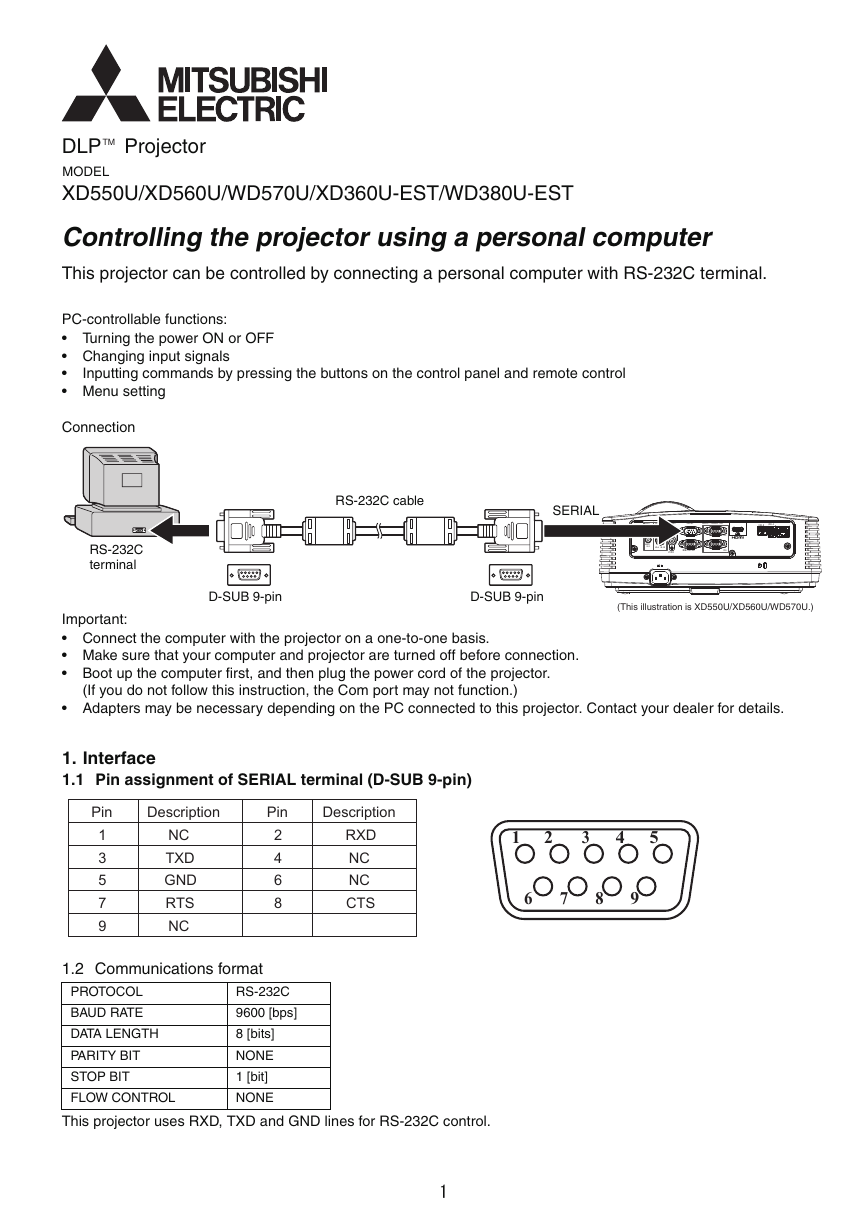
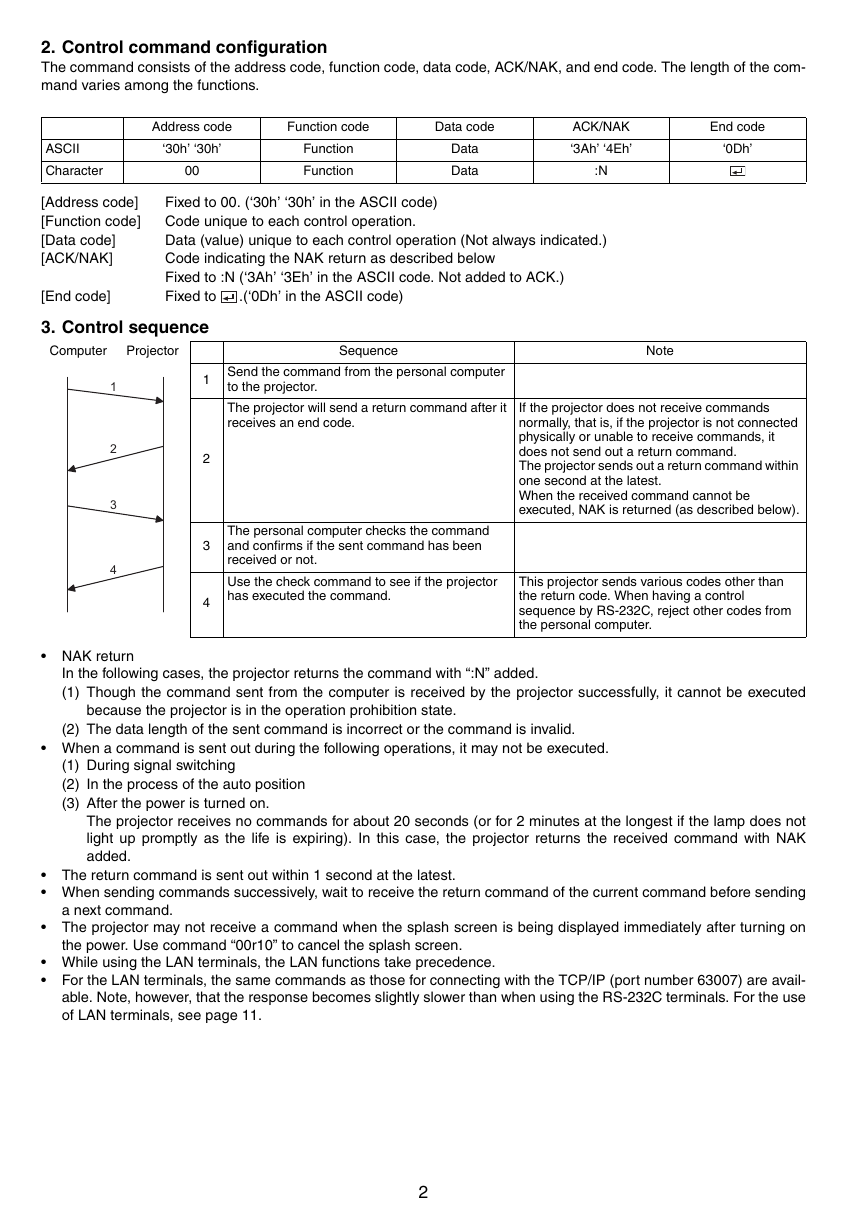
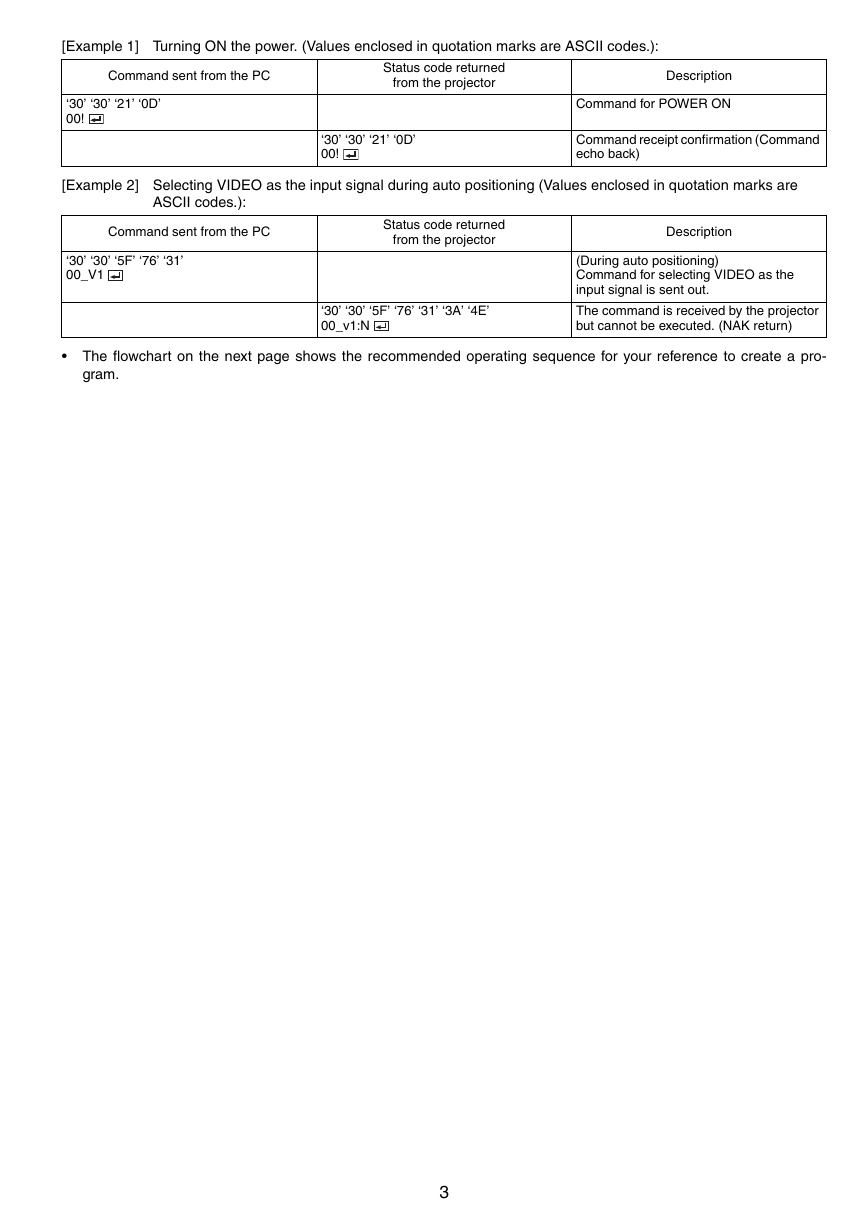
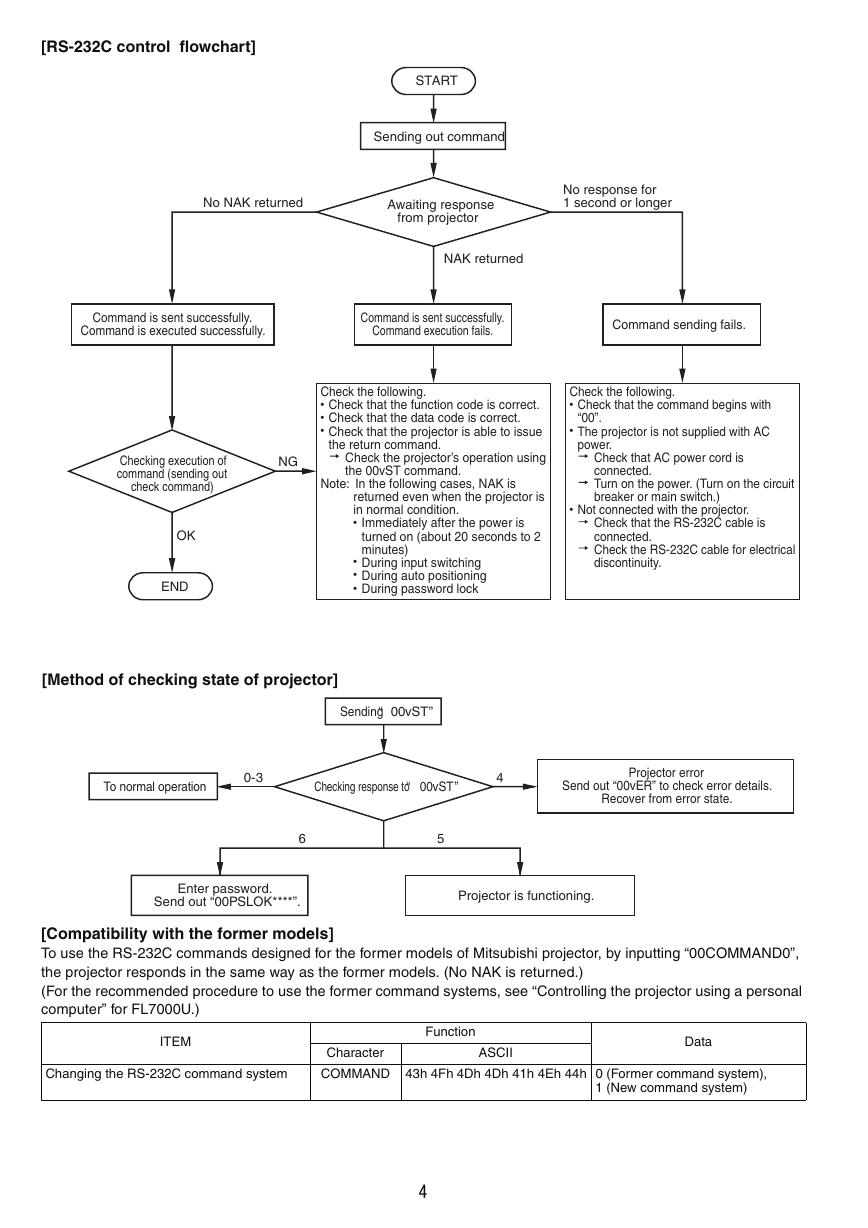

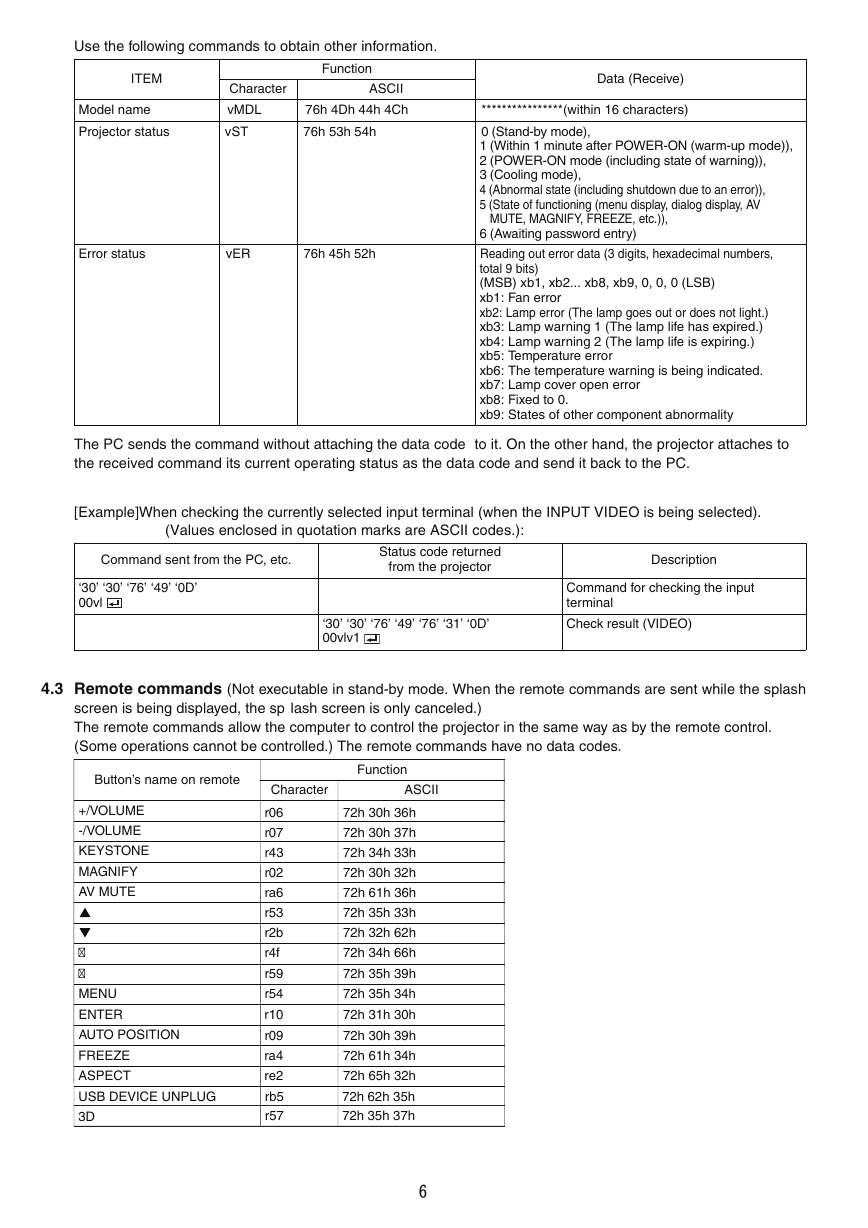
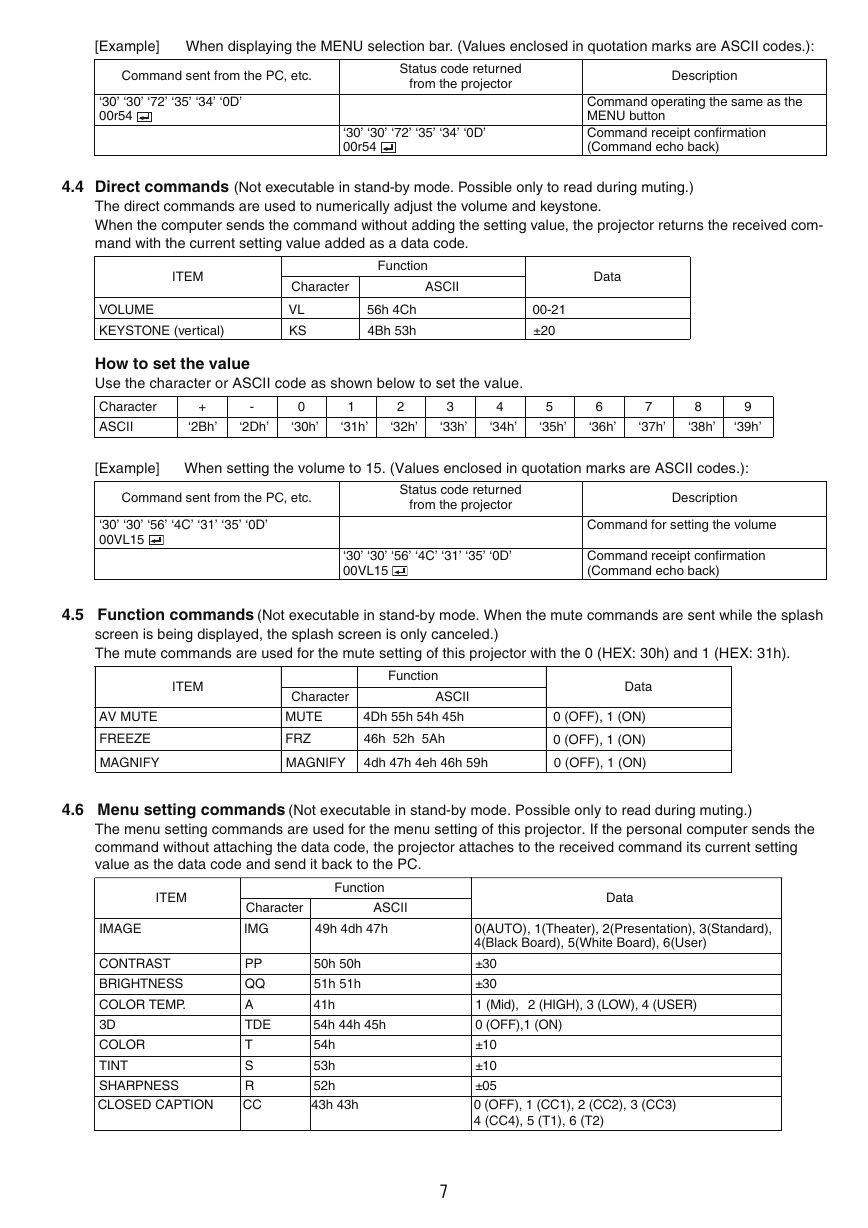
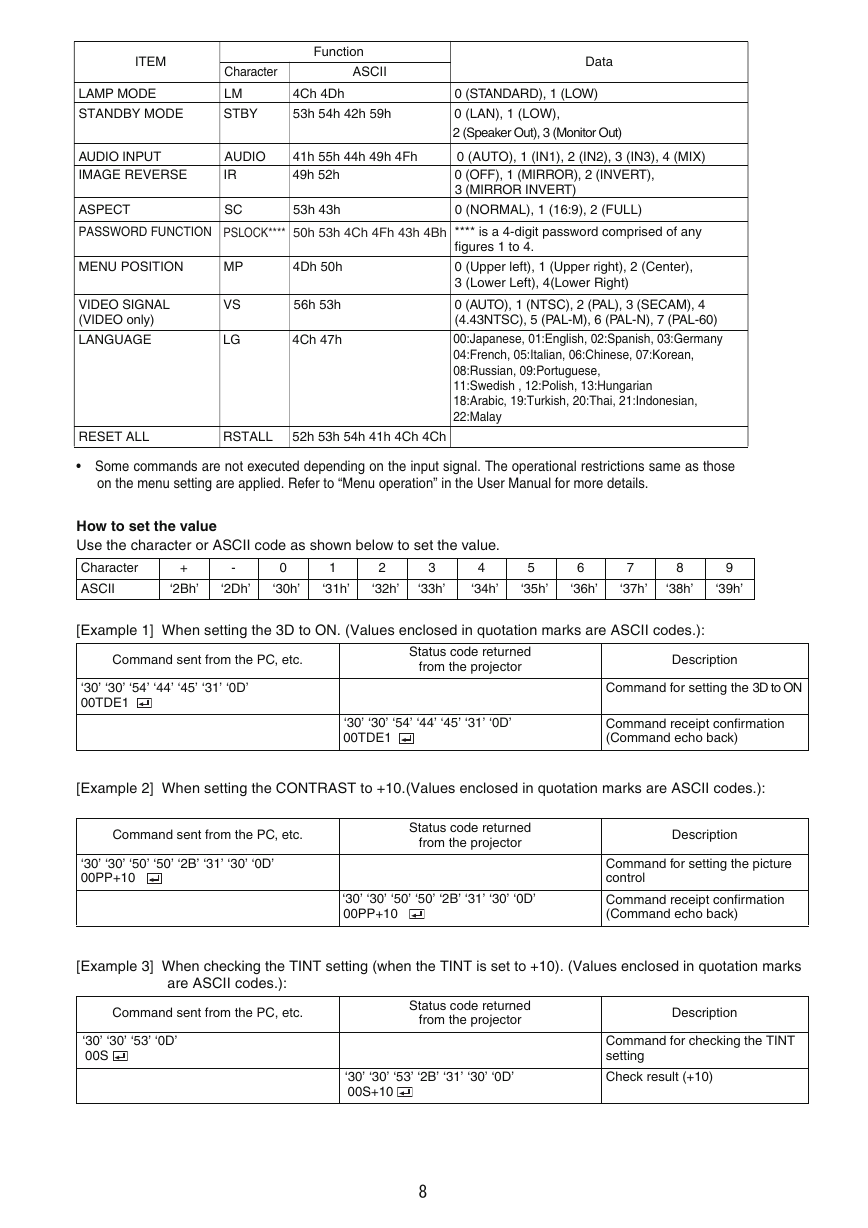








 2023年江西萍乡中考道德与法治真题及答案.doc
2023年江西萍乡中考道德与法治真题及答案.doc 2012年重庆南川中考生物真题及答案.doc
2012年重庆南川中考生物真题及答案.doc 2013年江西师范大学地理学综合及文艺理论基础考研真题.doc
2013年江西师范大学地理学综合及文艺理论基础考研真题.doc 2020年四川甘孜小升初语文真题及答案I卷.doc
2020年四川甘孜小升初语文真题及答案I卷.doc 2020年注册岩土工程师专业基础考试真题及答案.doc
2020年注册岩土工程师专业基础考试真题及答案.doc 2023-2024学年福建省厦门市九年级上学期数学月考试题及答案.doc
2023-2024学年福建省厦门市九年级上学期数学月考试题及答案.doc 2021-2022学年辽宁省沈阳市大东区九年级上学期语文期末试题及答案.doc
2021-2022学年辽宁省沈阳市大东区九年级上学期语文期末试题及答案.doc 2022-2023学年北京东城区初三第一学期物理期末试卷及答案.doc
2022-2023学年北京东城区初三第一学期物理期末试卷及答案.doc 2018上半年江西教师资格初中地理学科知识与教学能力真题及答案.doc
2018上半年江西教师资格初中地理学科知识与教学能力真题及答案.doc 2012年河北国家公务员申论考试真题及答案-省级.doc
2012年河北国家公务员申论考试真题及答案-省级.doc 2020-2021学年江苏省扬州市江都区邵樊片九年级上学期数学第一次质量检测试题及答案.doc
2020-2021学年江苏省扬州市江都区邵樊片九年级上学期数学第一次质量检测试题及答案.doc 2022下半年黑龙江教师资格证中学综合素质真题及答案.doc
2022下半年黑龙江教师资格证中学综合素质真题及答案.doc